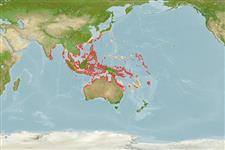Common names from other countries
Environment: milieu / climate zone / depth range / distribution range
Écologie
Récifal; profondeur 1 - 15 m (Ref. 100937). Tropical; 36°N - 27°S, 34°E - 180°E (Ref. 847)
Distribution
Pays | Zones FAO | Écosystèmes | Occurrences | Introductions
Indo-Pacific.
Length at first maturity / Taille / Poids / Âge
Maturity: Lm ? range ? - ? cm Max length : 100.0 cm WD mâle / non sexé; (Ref. 269)
Description synthétique
Morphologie
Colonies form large plates covered with thin, high collines that form radiating valleys. The plates may be more than 1 m in diameter while the colonies may reach several centimeters in height. Corallites are widely spaced with septocostae continuous between them (Ref. 269). Zooxanthelate (Ref. 19).
Maximum depth from Ref. 98471. Common from below the reef flat to the limit of coral growth (Ref. 269). Also in lower reef slopes and turbid water (Ref. 98471). Has high bleaching level and high estimated mortality in Palau (Ref. 66144).
Life cycle and mating behavior
Maturité | Reproduction | Frai | Œufs | Fécondité | Larves
Hermaphroditic (Ref. 113712). Mature gametes are shed into the coelenteron and spawned through the mouth. Life cycle: The zygote develops into a planktonic planula larva. Metamorphosis begins with early morphogenesis of tentacles, septa and pharynx before larval settlement on the aboral end (Ref. 833).
Hodgson, G. 1998. (Ref. 269)
Statut dans la liste rouge de l'IUCN (Ref. 130435)
statut CITES (Ref. 108899)
Not Evaluated
Utilisations par l'homme
| FishSource |
Outils
Sources Internet
Estimates based on models
Preferred temperature
(Ref.
115969): 25.2 - 29.3, mean 28.7 (based on 2397 cells).
Vulnérabilité
High vulnerability (60 of 100).
Catégorie de prix
Unknown.
